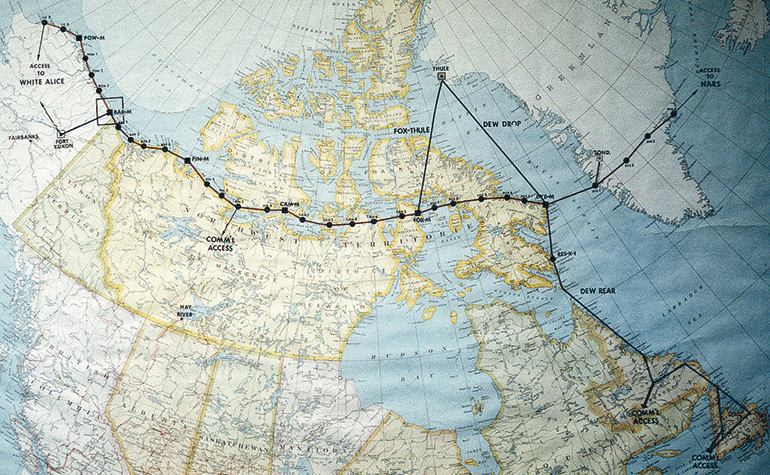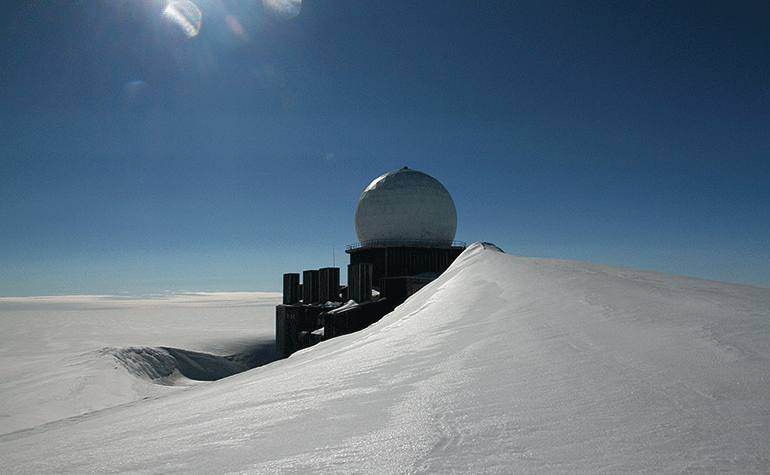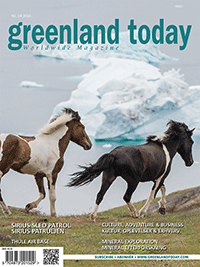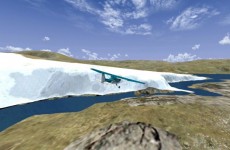
The dart is still in the dartboard and the beer is still on the counter in the bar. So untouched is DYE-2. Slowly, the weather and wind have encroached and in a few years it will probably be difficult to get in and see this unique, American cold war relic on the ice sheet in Greenland.
Text: Toke Brødsgaard, greenland today July 2015
There is an air of mystery when you move around the now abandoned DYE-2 radar station which is located quite a long way out on the ice cap in Greenland. The site remains so untouched that it is as if everyone left the place at the same time when it was abandoned in October 1988.
Moving around the build-ing, you can see rooms, bars and workshops in the same state in which they were left. The only evidence that time has passed, is that the weather has broken some windows and the snow has sneaked in and disturbed the peace.
In the middle of nowhere
The former radar station DYE-2 is located at 66° 29′ 30″ N, 46° 18′ 19″ W. If you fly in with one of Air Greenland’s helicopters, it takes about one hour and 20 minutes from Kangerlussuaq which is the nearest civilisation. DYE-2 is situated about 2,300m above sea level, solidly »planted« on the ice sheet.
The flight out is beautiful, over the mountains at Kangerlussuaq and onwards over the ice sheet. The first thing you see is the flat dark ice mixed with deposited gravel at the edges. The journey then continues over rugged ice that towers up like church steeples or castle turrets. The ice flattens out and you fly over beautiful royal blue meltwater rivers and lakes until everything becomes white in white.
In the distance, you can suddenly discern a tiny black speck that gets bigger and bigger. At last, you can see that it is the enormous football-like dome which is the actual radar at DYE-2. Although this is the destination for the journey, it is surprising to find this huge building out in the middle of nowhere.
 Map showing the »Distant Early Warning (DEW) Line« which DYE-2 was part of.
Map showing the »Distant Early Warning (DEW) Line« which DYE-2 was part of.
The Distant Early Warning Line
DYE-2 was a major undertaking. At its most active, there were 60 men at the station. The fact that the building was able to accommodate such a large staff during periods when it was impossible to go outside because of cold and storms says a lot about its size.
Strategically, DYE-2 was in an important position, since it was a part of the Distant Early Warning (DEW) radar line. It was established to warn of any Soviet air attacks against the USA during the cold war. The DEW Line consisted in Greenland of DYE-1, which is located just outside Sisimiut, DYE-2 and DYE-3, which are located further to the east on the Greenland ice sheet and DYE-4 which is located not far from Kulusuk in East Greenland.
DEW was a chain of a total of 60 radar stations stretching over a 5,800km long line along the 69th parallel north from Alaska over Canada via Greenland to Iceland. The actual radar chain was active from July 31st 1957 until the end of the 1980s.
 During the construction of DYE-2.
During the construction of DYE-2.
The construction of DYE-2
DYE-2 itself was something of a construction project. All the material was manufactured in the USA and sailed to the base at Kangerlussuaq, which was called Bluie West 8 (BW8) in those days. From there, the material was loaded into the large C-130 transport aircraft which were equipped with skis and able to land close to the DYE-2 construction site.
The foundation is an enormous steel framework consisting of 16 columns, most of which are covered by ice today. The construction required a huge effort and the teams working on construction worked 10 hours a day, seven days a week. In November 1960, after two years’ work, the facility was complete.
Shutting down DYE-2
DYE-2 was shut down in October 1988. Mechanic Torben Simonsen turned off the last generator. He had worked on DYE-1, DYE-2 and DYE-3.
The radar chain was shut down because modern technology had overtaken and made the radar stations obsolete. In addition, several of the stations, including DYE-2, were threatened year after year by the encroaching snow and ice.
When DYE-2 and DYE-3 were shut down, there was no longer any need for the BW8 base which had been used as a supply base for the DYE stations and the base was closed in 1992.
 The abandoned radar station DYE-2.
The abandoned radar station DYE-2.
Continued American activity
Although the radar station has been abandoned there are still people nearby. Very close to DYE-2 is Camp Raven, which is run by the American National Science Foundation (NSF). Camp Raven is the place in the Arctic where, since 1995, Americans have trained landing their ski-equipped Hercules LC-130 aircraft.
This training is important to the Americans because it enables them to land at the South Pole, where they have many research activities. On a smaller scale, these also take place in Greenland, e.g. at Camp Raven, where sensors in the ice are used to study how much the Greenland ice cap moves each year.
From spring to autumn, a young married couple from USA live at Camp Raven. They prepare the runways and clear snow from around the fuel depots. This must have been what life was like at DYE-2 and it is fascinating to meet people who live isolated on the ice cap in the middle of the »the big white nothing«.
See more
lswilson.dewlineadventures.com











